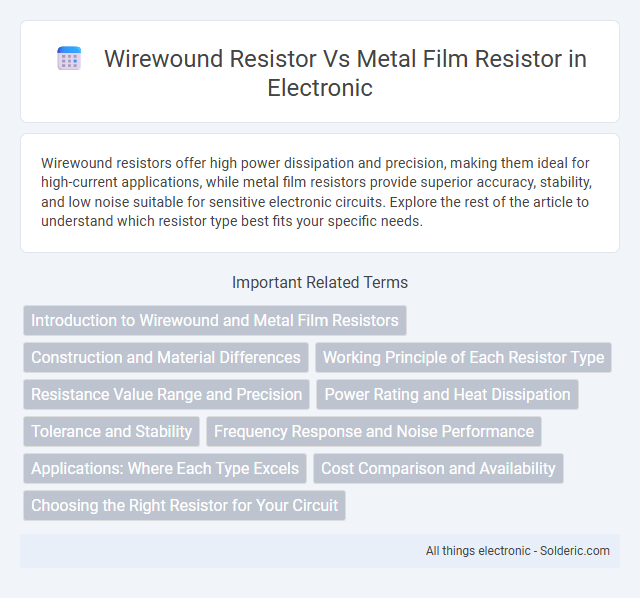Wirewound resistors offer high power dissipation and precision, making them ideal for high-current applications, while metal film resistors provide superior accuracy, stability, and low noise suitable for sensitive electronic circuits. Explore the rest of the article to understand which resistor type best fits your specific needs.
Comparison Table
| Feature | Wirewound Resistor | Metal Film Resistor |
|---|---|---|
| Material | Metal wire wound on ceramic core | Thin metal film deposited on ceramic substrate |
| Resistance Range | 0.1 O to 100 kO | 1 O to 10 MO |
| Power Rating | Typically 0.5W to 50W | Typically 0.1W to 2W |
| Tolerance | +-1% to +-5% | +-0.1% to +-5% |
| Temperature Coefficient | Higher, ~50 ppm/degC | Lower, ~5 to 25 ppm/degC |
| Noise Level | Higher, due to wire winding | Lower, stable metal film structure |
| Frequency Response | Limited, inductive effects | Better, low inductance |
| Applications | High power, precision current sensing | High accuracy, low noise circuits |
| Cost | Higher due to construction | Generally lower |
Introduction to Wirewound and Metal Film Resistors
Wirewound resistors feature a wire coil wound around a ceramic, plastic, or fiberglass core, offering high precision and excellent power handling, ideal for high-power applications. Metal film resistors consist of a thin metal layer deposited on an insulating substrate, providing superior stability, low noise, and tight tolerance for precision circuits. Understanding the differences between wirewound and metal film resistors helps you select the most suitable component for your specific electronic design needs.
Construction and Material Differences
Wirewound resistors consist of a metal wire, usually nichrome or copper-nickel alloy, wound around an insulating ceramic core, offering high durability and excellent power handling. Metal film resistors are made by depositing a thin layer of metal, such as nickel-chromium, onto a ceramic substrate, providing superior precision and low noise. Your choice depends on whether you need the ruggedness and heat tolerance of wirewound types or the accuracy and stability of metal film resistors.
Working Principle of Each Resistor Type
Wirewound resistors operate by winding a metal wire, usually nichrome, around a ceramic or fiberglass core, converting electrical energy into heat through resistive losses. Metal film resistors consist of a thin metal layer deposited on a ceramic substrate, where resistance is controlled by the thickness and length of the metal film. The wirewound type excels in power handling and inductance control, while metal film resistors offer precise resistance values with low noise and stability in various temperature conditions.
Resistance Value Range and Precision
Wirewound resistors typically offer resistance values ranging from 0.1 ohms to several kilo-ohms with precision levels around +-1% to +-5%, making them suitable for high-power applications but less ideal for precision circuits. Metal film resistors provide a wider resistance value range, from 1 ohm to 10 megaohms, with tighter tolerance levels as low as +-0.1% to +-1%, ensuring high accuracy and stability in sensitive electronic devices. The superior precision and broad resistance options of metal film resistors make them preferable for applications requiring exact resistance values and low noise characteristics.
Power Rating and Heat Dissipation
Wirewound resistors typically offer higher power ratings, often exceeding 5 watts, due to their construction using metal wire coils, which allows efficient heat dissipation and makes them suitable for high-power applications. Metal film resistors generally have lower power ratings, commonly around 0.25 to 1 watt, with heat dissipation limited by their compact size and thin film structure, making them ideal for precision, low-power circuits. The enhanced thermal conductivity of wirewound resistors ensures better heat management under heavy loads, while metal film resistors require careful thermal consideration to avoid performance degradation.
Tolerance and Stability
Wirewound resistors offer excellent stability and low temperature coefficient, making them ideal for applications requiring precise tolerance over time and varying conditions. Metal film resistors typically provide tighter initial tolerance values, often as low as 0.1%, but may exhibit slightly less long-term stability compared to wirewound types. Your choice depends on whether long-term stability or initial precision is more critical for your circuit's performance.
Frequency Response and Noise Performance
Wirewound resistors exhibit superior frequency response at low frequencies due to their inductive nature but suffer from increased inductance and decreased performance at higher frequencies. Metal film resistors provide excellent noise performance with low excess noise and minimal inductance, making them suitable for high-frequency applications. Your choice depends on whether low-frequency stability or minimal noise in high-frequency environments is more critical.
Applications: Where Each Type Excels
Wirewound resistors excel in high power applications, such as power supplies, amplifiers, and motor controls, due to their ability to handle higher wattage and withstand heat. Metal film resistors are ideal for precision circuits, including audio equipment, measurement devices, and low-noise applications, offering superior stability and accuracy. Your choice depends on whether you prioritize power tolerance or precision performance.
Cost Comparison and Availability
Wirewound resistors typically cost more than metal film resistors due to their complex manufacturing process and use of metal wire materials. Metal film resistors are widely available and less expensive, making them a popular choice for general-purpose applications. When selecting components for your project, consider metal film resistors for cost efficiency and easy procurement.
Choosing the Right Resistor for Your Circuit
Wirewound resistors offer high precision and power handling, making them ideal for applications requiring durability and low noise, especially in high-current circuits. Metal film resistors provide excellent stability, low tolerance, and minimal temperature coefficient, suited for sensitive electronic devices demanding accuracy and low thermal noise. When choosing the right resistor for your circuit, consider factors such as power rating, tolerance, temperature stability, and the operating environment to ensure optimal performance and reliability.
Wirewound resistor vs metal film resistor Infographic

 solderic.com
solderic.com